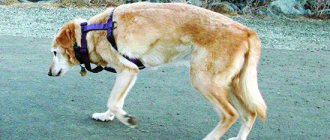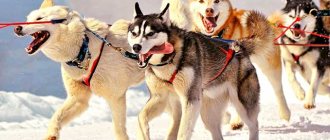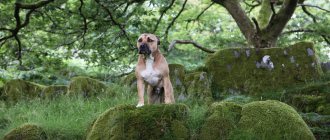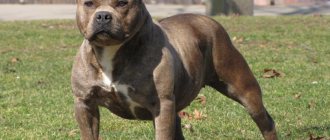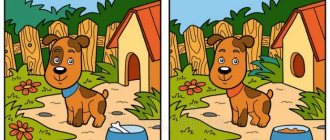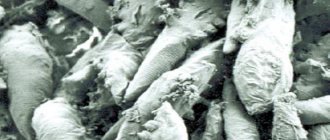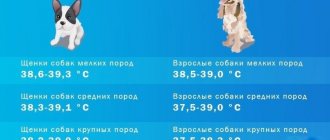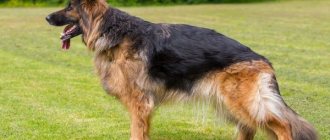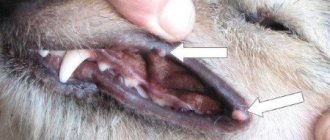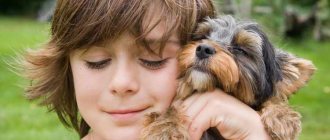Characteristics of "status"
The wolfhound dog breed does not exist as such - it is a collective concept about dogs of large breeds, each of which has its own character, behavior, appearance, but they have one thing in common - they are all bred to protect livestock from attacks from predators, and in some cases - and hunting them. These animals are distinguished by their large size - from 70 cm at the withers and above, and quite large weight - from 80 kg.
Dogs with the honorary status of “wolfhound” are distinguished by the following features:
- endurance;
- stable psyche;
- excellent sense of smell;
- immunity to bad weather;
- good health.
Popular breeds
Each representative of its breed has a unique character and its own manner of behavior. Before inviting a representative of the wolfhound family into your home, determine for yourself what you want from this dog, what role it should play: a formidable guardian, a loyal friend, or a gentle giant?
Irish
Irish Wolfhound: two words are suitable to describe this breed - caring nanny. Smart and patient, kind and affectionate, such a gentle dog in character, but menacing in appearance.
Consider the most popular breeds of hunting dogs: Saluki, Greyhound (English Greyhound), Russian Greyhound, Russian-European Laika, American Cocker Spaniel, Parson Russell Terrier, Smooth Fox Terrier , “Norwich Terrier”, “Russian Spaniel”, “Russian Piebald Hound”, “English and American Foxhounds”.
The Irishman is an ideal find for a large family with small children and extensive private property to protect. This dog does not show aggression, is patient and gentle with children, he cannot stand loneliness and loves to be around people.
The Irishman is a very trainable pet and easily learns new commands. When training an Irishman, be collected, they cannot stand rough treatment and, offended, ignore the offender. Agree: it’s unpleasant when you, as the owner, are ignored. To maintain the health of your pet, regular and long walks and physical activity during training are vital.
Did you know? The Irish Wolfhound is one of the tallest dogs. Its height at the withers reaches 90 cm, and when it rises on its hind legs, its height significantly exceeds the height of a person.
Caucasian
The Caucasian Wolfhound is an animal for experienced and powerful people; this breed is not suitable for novice dog breeders. The Caucasian is distinguished by his intelligence, strong and strong-willed character, and the ability to make independent decisions, sometimes ignoring the demands of the owner.
The dog is easy to train, but it must be handled by a balanced person with a strong and firm character. The dog does not tolerate aggression, shouting, or assault. During classes, clear and concise commands should be given. The Caucasian is a very devoted dog who, without hesitation, will give his life for his owner.
In addition to the Caucasian wolfhounds, the Molosser group also includes: “American Bulldog”, “Dogo Argentino”, “Dogue de Bordeaux” (“French Mastiff”), “Bullmastiff”, “African Boerboel”, “Spanish Mastiff”, “Ca-de- Bo”, “Caucasian Shepherd Dog”, “Cane Corso”, “Leonberger”, “Pug” and “Neapolitan Mastiff” (“Mastino Neapolitano”).
The Caucasian is tall, his height at the withers is 63 cm, large and hardy, an excellent watchman and protector. They keep a pet in an enclosure, but if you keep it on a chain, its character will deteriorate, it will become irritable and aggressive.
Important! Caucasian Shepherds are one of the few dogs that, with proper training, are able to perform their duties without commands or human intervention.
Mongolian
The Mongolian Wolfhound is a family pet, calm and calm. He feels great both in a booth in the yard and in an apartment on a rug - he does not like to embarrass you with his presence. This dog has a balanced character, adequate behavior and a cheerful disposition.
The Buryat-Mongolian wolfhound (hotosho) is very attached to the house in which it lives, to the owner and his family. He is easily trained and can quickly assess a situation and respond accordingly. If there are children in the family where the dog lives, she takes on the role of nanny and guardian. He is very curious and, strange as it may sound, has an excellent sense of humor.
Russian
The Russian Greyhound is a dog with an aristocratic appearance. It is difficult to pass by such a dog: proud head carriage, long silky hair, elongated paws, graceful movements. In tsarist times, this animal was the favorite breed of the nobility, because it had no equal in hunting. The Russian greyhound easily caught up and held the wolf, could strangle it, but no more, this dog is not a wolfhound (in the full sense of the word).
Read more about the characteristics of the Russian Greyhound breed.
The Russian Canine is one of the smartest hunting dogs, it is able to remember and use complex tricks. But during training she can “spoil a lot of blood”, since she is quite stubborn and tries to do only what she herself wants. When training, it requires a gentle approach, does not like shouting, rough methods make the dog nervous. This pet can live quite calmly in an apartment, loves to stretch out on the sofa and will willingly watch TV with its owner, but only if it has previously been subjected to significant exercise during a walk. This dog is very clean, she licks herself like a cat.
Important! The Russian greyhound has highly developed instincts - their centuries-old hunting memory is fresh. You should not keep a greyhound in the same house with other animals; at any moment it can forget itself and start hunting them.
Important! The Russian Greyhound is prone to a disease called volvulus. This disease occurs when the dog is allowed to exercise after eating.
Central Asian
The Central Asian Shepherd Dog, or, as it is also called, the Turkmen Wolfhound or Alabai, is a dog known not only for its impressive size, but also for its remarkable working qualities. This is a guard dog, she carefully protects the herds of domestic animals entrusted to her and the integrity of your home.
The Asian wolfhound is an independent, fearless dog, he is always ready to defend his own, and, without hesitation, will give his life for his owner. His character is complex, prone to dominance; dog experts do not advise everyone to have this breed. After appropriate training, he makes a good companion - friendly, calm, self-confident, but such a dog is not suitable for families with small children.
Like the Central Asian Wolfhound, herding dogs also include the following breeds: Entlebucher Mountain Dog, Border Collie, Central Asian Alabay Shepherd Dog, Caucasian Shepherd Dog, Bernese Mountain Dog and French Briard Shepherd Dog.
Iberian
A powerful dog with a muscular body, hardy and physically strong. He has an independent disposition and likes to occupy a leading position, so he will take a strong-willed and rather tough person for the owner.
Did you know? Since 1675, the Pyrenean dog received the official title - French court dog; it was considered an excellent guard, hunter and shepherd all rolled into one.
This dog needs a lot of space, so a city apartment is not for it, but in a country house with a large plot, it will feel in its place. The dog gets along well with other pets, but it treats people much worse and, without proper socialization, can attack them for no reason.
Armenian
An intelligent and fearless dog, from time immemorial it has served man, protecting him, his property and his animals. The Armenian wolfhound (gampr) is capable of making decisions independently and, as practice shows, it almost never makes mistakes. He is not aggressive, adequate in his actions, balanced, and easy to train.
Did you know? The female of the Armenian wolfhound raises the males of the Armenian wolfhound for military action against the wolf; she leads them with her up to a certain moment, but as soon as a fight with the wolf begins, the female moves aside.
Gampr is a dog with a kind heart; she sincerely loves the family in which she lives. They treat guests kindly, adores women and children, but his soul belongs to the owner.
Bavarian
Fearless, agile, with an excellent reaction - this is how the Bavarian wolfhound, or Giant Schnauzer, is represented. He instantly reacts to stimuli, his attacks are lightning fast, and his strength and reaction speed help him cope with any opponent.
The Giant Schnauzer is a pet for active people, suitable for families with small children.
Cheerful, temperamental, childish, with a sensitive attitude towards household members, a brave dog. He tolerates the conditions of city apartments well, but to maintain health he needs regular exercise and long walks.
How to protect a dog from a wolf
I often heard complaints from hunters that dogs, mainly hounds and partly huskies, which have the habit of working far from the hunter, die in the teeth of wolves.
Moreover, this problem is not only for Belarusian hunters; I also heard this from hunters in the Vologda and Arkhangelsk regions during my service in the Soviet army.
This problem comes not only from wolves, but also from dog-wolf hybrids, as well as from packs of stray dogs that have chosen hunting grounds as their “personal territory.”
The problem of wolf-dog hybrids - very brave, decisive and arrogant predators - is not yet too acute in Belarus, but we have plenty of wolves and stray dogs.
I never encountered a wolf during hunts, but there were encounters with packs of “vagrants” of five heads during a feather hunt with my drathaar. I don’t know what would have happened to the dog if I hadn’t been there, it seems that stray dogs have a lot of experience and know the danger a person with a gun poses to them.
The dogs we met got up from their beds, quickly ran away to a safe distance and from there began to bark at us passionately.
But, as you know, the pointer works close to the hunter and is therefore more or less protected. Hounds and huskies are in a much more vulnerable position.
But dogs are one thing and wolves are quite another. These animals skillfully “remove” both the hound from the rut and the husky working on the animal. According to the injured hunters, the wolves do this so masterfully that the dog doesn’t even have time to utter a word. And you don’t need to rely on the power and teeth of your Anglo-Russian dog or West Siberian husky dog. The wolf is still more powerful and more skilled, and besides, the grays never hunt alone.
And one more factor: dogs don’t eat wolves, but wolves devour our four-legged friends for their sweet souls, sometimes even preferring dog meat to any other meat.
It follows from this that we ourselves have to protect our friends from wolves. Surprisingly, despite cases of wolves attacking dogs, our hunters, at least those with whom I had to communicate, do not take any measures to prevent such emergencies.
Therefore, let's turn to the experience of Russian hunters, who have some experience in this regard.
Our fellow countryman, who by the will of fate became a Siberian, told us about the simplest method. According to him, Siberian hunters, having come to lands where there may be wolves (and there they are everywhere), fire several shots into the air before letting the hounds crawl. According to him, this is often enough for wolves to either hide in the supports or completely leave the land out of harm’s way. In any case, according to the Belarusian Siberian, after the hunters began to warn the gray robbers that the dog was in the forest with the owner and that the owner’s intentions were serious, the attacks on the hounds stopped.
In addition, the experience of Karelia hunters is very interesting. There, in order to protect their dogs from wolves, hunters tie strips of red fabric (ribbons) to their collars. According to hunters, this method turned out to be very effective. Despite the significant increase in the wolf population in Karelia, not a single attack on dogs with security tapes has been recorded.
The method seems to be really good, but I would like to make some amendments. According to zoologists, wolves, as well as dogs, are partially colorblind, so, in my opinion, the ribbons that are tied to the collar can be of any color. It seems that what scares away the gray robbers is not so much the fluttering of the ribbons or their color, but the human smell (matter has the ability to adsorb and retain odors very well).
In addition, when using tapes, the likelihood of getting caught on a branch increases many times over. Therefore, it is imperative to select a fabric that can be easily torn if necessary.
The described method can be easily modernized. What if, instead of rag tapes on the collars, you put specially made vests on your dogs before hunting? Fortunately, there are now quite a lot of craftsmen who are engaged in sewing special dog clothes.
Such a vest can protect not only from wolves (the larger the area of the material, the stronger the human smell), but also from bad weather (if it is sewn from raincoat fabric), from sharp twigs and thorns (if it is made of sufficiently dense fabric), and also from “sharp” shooters, especially inside the pen, if it is some kind of “acid” color - green, like the traffic police officers, or, say, red... Share on social media. networks:
Previous Next
